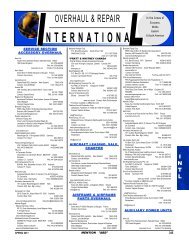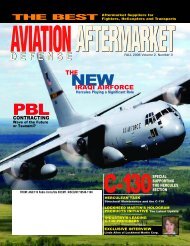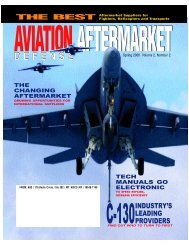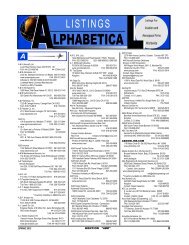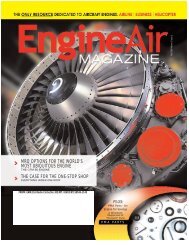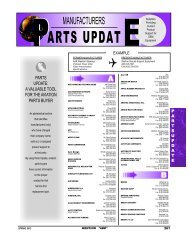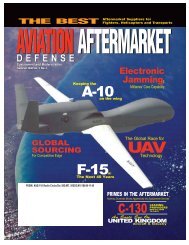Create successful ePaper yourself
Turn your PDF publications into a flip-book with our unique Google optimized e-Paper software.
(HASC), and the Congressional Research<br />
Service, either declined to speak to<br />
Aviation Aftermarket Defense Magazine<br />
on the subject, or would speak only on<br />
background. We received the same<br />
response from several Senators and<br />
Congresspersons, and their staffers,<br />
known to address such issues of national<br />
defense.<br />
Nevertheless, off-the-record<br />
briefings, the public record,<br />
conversations with members of the<br />
aerial refueling community and defense<br />
analysts, and the Haddon-Cave Review<br />
taken together make it possible to come<br />
to reasonable conclusions about the<br />
mechanisms in place to identify safety<br />
issues and the potential for system<br />
failures in U.S. aerial refueling<br />
operations.<br />
SAFETY FIRST<br />
In 1978, a small group of military and<br />
civilian aerial refueling experts<br />
interested in furthering the safety and<br />
efficiency of refueling operations met at<br />
Strategic Air Command Headquarters in<br />
Omaha, Nebraska. The group began<br />
developing common standards for<br />
refueling operations and equipment,<br />
and it grew to become the Aerial<br />
Refueling Systems Advisory Group<br />
(ARSAG).<br />
ARSAG's first technical document,<br />
issued in 1985, was written in response<br />
to a request that the U.S. Air Force<br />
received from the Federal Republic of<br />
Germany (West Germany) to conduct<br />
KC-135 refueling operations with a West<br />
German Luftwaffe Panavia Tornado.<br />
ARSAG developed the standards for the<br />
procedures and equipment employed in<br />
the refueling. In the years since, ARSAG<br />
has developed the standards for all<br />
phases of aerial refueling that are used<br />
by United States, NATO members, and<br />
other air forces around the globe.<br />
Now known as ARSAG International,<br />
the organization is chartered as a<br />
Department of Defense Joint<br />
Standardization Board (JSB) under the<br />
Defense Standardization Program (DSP).<br />
AIRCRAFT REFUELING<br />
Through this JSB mandate, ARSAG<br />
develops standards, procedures, military<br />
specifications, and NATO<br />
Standardization Agreements (STANAGS)<br />
and designs aerial refueling systems.<br />
ARSAG standards for NATO's air-to-air<br />
refueling are codified in ATP-3.3.4.2 and<br />
ATP-56(B), last updated in January of<br />
2010. The document sets airspeeds for<br />
refueling, light signals, and all other<br />
operational procedures.<br />
From rendezvous to breakaway,<br />
every facet of aerial refueling and every<br />
emergency procedure is defined by<br />
ARSAG, both for fixed-wing and rotary<br />
aircraft. (Refueling standards for tilt-rotor<br />
aircraft are in development.) ARSAG also<br />
develops maintenance standards for<br />
refueling equipment. The group works<br />
year round, and it holds an annual<br />
meeting that draws civilian and military<br />
members from as many as eighteen<br />
countries for panels and seminars.<br />
Aerial refueling also is provided via<br />
private contractors to the U.S. Navy and<br />
U.S. Marine Corps. Omega Air, of<br />
WWW.ABDONLINE.COM AVIATION AFTERMARKET <strong>DEFENSE</strong> | SPRING 2010<br />
Photo Courtesy Boeing<br />
25



